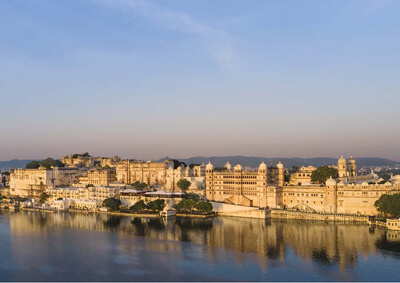A Palatial Stay Awaits at Bari Kothi
A Palatial Stay Awaits at Bari Kothi
Retreat to this centuries-old palace in Murshidabad, the seat of Bengal’s Nawabs in the 1700s, and get lost in its history and understated grandeur. Bari Kothi is the perfect getaway, not too far from Calcutta city

Text: Malini Banerjee
In the middle of March, just as winter waned and spring felt like summer, I spent an idyllic two days getting a taste of a slower form of life. Roughly 240 kms from Calcutta in a small riverside village of Azimganj in Murshidabad, Bari Kothi is a centuries-old palace.
The journey is best made by train I was told, since the approach via road involved mounting one’s vehicle on rickety bamboo barges and would take nearly two hours more. A train on the other hand would reach me in four hours. Even that seemed like a novelty since I had not been on a train in ages. I got a window seat, tucked my feet under and watched verdant rural Bengal whizz past, checking out names of quaint stations over cups of milky tea and Elizabeth Strout’s latest on my Kindle.
At Azimganj City (would you believe it, the teeny town had two stations – Azimganj City and Azimganj Junction) the sight of the platform lined with cheery bougainvillea in full fuchsia bloom set the holiday mood. I was greeted by Bari Kothi’s staff at the platform and took a toto – the ubiquitous auto-like ride popular across rural Bengal. Less than 10 minutes later I reached the hotel and was welcomed by a team of women clad in traditional red and white saris.
Regal history
Over a glass of refreshing lemonade, Ahirup Ghosh, the resident manager (he prefers to be called Captain of the Ship) briefed me about Bari Kothi’s history and how it aligned with that of Murshidabad. Bari Kothi’s owners, the Dudhorias are Sheherwali Jains. They belong to a community of migrant business traders and bankers from Rajasthan who were invited to stay and build businesses in Murshidabad, the seat of Bengal’s Nawabs in the 1700s. As the area's fortunes changed after the battle of Plassey, their businesses too slowly moved to Calcutta. But the Dudhoria estates and palace remained even as the family built a life in the capital. The home of the eldest Dudhoria came to be called Bari Kothi, since bari means elder. The small town is littered with similar grand and small zamindari homes, all of which belonged to this trading community who once lived in Azimganj, and till date many have country homes here.
After the chat, I was soon shown to my room that was in the “women’s wing”. The walls were bedecked with frames evidence of “womanly arts” – embroidery, tiny clothes designed for dolls and God’s idols. The heritage room titled the Diamond Room was dressed up in blue and white, and furnished to a yesteryear tune with an antique four-poster, armoire, a chaise lounge. An old-school marble top console had a selection of teas and coffees and even a tiny French press so that one could brew one’s own cuppa. A footstool placed under the bed was supposed to help one climb into the bed.
Shopping and feasting
A quick shower later, lunch awaited. Lunch was going to be a traditional Sheherwali many-course affair at the Durbar Hall. Not being pre-warned I had second helpings of dahi wada and only later did I realise that I had three more courses to go! The light flavourful dahi khichdi was cooling and comforting in the heat. Madiya, that is a flavoured broth made out of rice starch, tempered with cumin, was my revelation of the day. This was a testament to the fact that zero-waste cooking can also be delicious.
After lunch and a brief walk around the property I went back to my room. Soon after a houskeeping staff dropped in with an ittar menu. I was asked to take my pick from mogra, rose, kasturi, white kasturi, juhi and other beautiful perfumes. I picked juhi, or jasmine, and the tiny roll-on ittar was applied all over the bed runners and the canopy. To drop into an afternoon siesta, the bed redolent of sweet jasmine – now that felt like true luxury.
Late afternoon, after a cup of tea, I was taken for a tour of the tnati para or the weaver’s neighbourhood. The classic rustling paper-like gorod sari, traditionally always made with red borders and white or cream base, was woven across the river in Jiaganj. I was taken to one such weaver's home who had a tiny shop front and three looms where I was invited to visit. Nowadays they weave beautiful mulberry silks in other colours, too. Being of the firm belief that one can never have too many saris I succumbed and bought a vivid peacock blue sari. Buoyed by a successful shopping trip I floated back across the river to the kothi to find the evening’s entertainment getting ready.
Next to the beautiful gaddi ghar my table was set overlooking the central courtyard. Over tea, morish cucumber pakoras and a light chickpea chaat I watched the evening’s Baul performance. Clad in their trademark saffron and patchwork Baul clothes they sang with gusto and broke into a dance, while a girl lit diyas for the evening aarti. The dulcet tones of the dotara, accompanied with songs of Bengal’s soil, as the lamps lit one by one, made for an unforgettably picturesque memory.
Another lavish dinner followed even though I was still full with the evening snacks. While the penultimate course included pan-Indian vegetarian dishes like shahi paneer, pulao and dal fry the courses in the middle were more traditional including missa (gram flour bread) methi tikra (a methi and spice-filled bread) dahi ka sabzi and more. Stomach filled to the brim one had to walk around the property’s seven courtyards to let the meal settle.
Riverine pursuits
Breakfast the next morning was al fresco and on the river banks. One would have expected it to be hot and enervating but was instead accompanied by a pleasant breeze and well-shaded with tall trees and garden umbrellas. I would have lingered over cups of tea and my book, but I did not want to miss out on a tour of the terracotta temples nearby.
While most know about the terracotta temples in Bishnupur this area is home to a few too. Built by Rani Bhabani in 18th century it was part of the zamindar queen’s dream to make another Kashi on the banks of Bhagirathi. Char Bungalow included four terracotta temples maintained by the ASI. The temples bore motifs that represented diverse faiths including Hindi, Buddhist, Jain, Islamic and Christian. It also depicted playful stories from our mythologies and one could have easily spent an entire day figuring out which mythological tale each terracotta tile depicted.
Post another leisurely lunch in yet another dining hall I took an evening stroll through the estate's organic farm and was served high tea on a boat. Watching children play by the banks, fishermen go back after the day's catch while I floated along the river over cups of tea and zingy jhalmuri as the sun set in the horizon, a Baul song lyric came to mind. Tomay hrid majha ray rakh bochereyde bona (I will keep you in my heart and not let you go). I can happily say the same for my Bari Kothi experience.
Bari Kothi
67R3+HFV, Jainpatty, Azimganj,
Murshidabad 742122
Mob: 0 90512 00800














